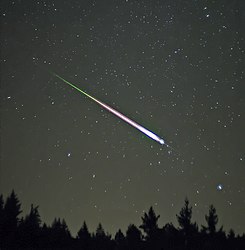狮子座流星雨
獅子座流星雨 (Leonids[ˈli.əˌnɪdz] lee-uhnids)是與周期大約33年的坦普爾·塔特爾彗星有關的一個流星雨。獅子座流星雨的得名是因為這個流星雨輻射點的位置在獅子座。
| Leonids | |
|---|---|
 拍攝於2009年的一顆獅子座流星 | |
| 發音 | /ˈliːənɪdz/ |
| 發現日期 | 902年(首次記錄)[1] |
| 母體 | 坦普爾·塔特爾彗星[2] |
| 輻射點 | |
| 星座 | 獅子座 |
| 赤經 | 10h 17m[3] |
| 赤緯 | +21.6°[3] |
| 性質 | |
| 出現時期 | 3 November – 2 December[3] |
| 峰值日期 | 17 November |
| 速度 | 70–71[3][4] km/s |
| 每小時天頂流星數 | 15[3] |
在2009年,獅子座流星雨的尖峰時間在11月17日(世界時),每小時的數量可能高達500顆,尚不足以成為流星暴(每小時超過1,000顆流星的大流星雨)。[5][6][7]
概述
编辑地球經常會通過彗星殘留下來的流星體質點溪流,在這種溪流裡包含了許多固體的流星體顆粒,而這些顆粒是彗星在接近太陽到木星軌道之內後,被太陽加熱使冰凍的氣體蒸發而連帶被噴射出來的,且典型的顆粒不大於塵埃的大小。流星主要的來源是流星體與空氣分子摩擦並汽化的塵埃 [1] (页面存档备份,存于互联网档案馆), 並且這些微小的碎屑與大氣層內單獨的原子碰撞會造成空氣的游離。當空氣的分子重新結合時,溫度會降低並釋放出光子。較大的顆粒會與較小的顆粒流分離,形成火流星或是火球,並在大氣中留下發光的軌跡。獅子座流星雨以有許多如此明亮的流星而著名。彗星每次回歸時都會在相似的軌道上留下許多的流星體,它們的差異是受到木星的擾動造成的(完整的說明請參考McNaught & Asher (1999) (页面存档备份,存于互联网档案馆))。歷次回歸的尾跡一起組成流星體的溪流,可是古老的尾跡已經不能產生壯觀的流星雨(每分鐘只有幾顆流星),因此雖然每年的11月17日都有流星雨,但每年的流星數量都會變化[8]。換言之,越年輕的尾跡在太空中有著越高的粒子濃度,當地球經過時也越容易形成流星暴,相較於週年的背景流星(每小時1到2顆)和流星雨背景(每小時數顆),每小時可以計量到超過1,000顆以上的流星[9]。
歷史
编辑狮子座流星雨最早的一次观测是在1833年11月12日的美国东部。到19世纪末,由于行星摄动远离地球,无法观测。但是到1966年11月17日,狮子座流星雨又重新出现,1998、1999、2001年的獅子座流星雨皆使全球天文愛好者為之雀躍。亦因為1998年之獅子座流星雨之預測失誤,修正了流星雨預測的精細方法。1998年的狮子座流星雨预测时间早于实际时间约24小时,导致大批观测者空守夜空。
2000s
编辑| 年份 | 活跃时间 | 极盛期 | ZHRmax |
|---|---|---|---|
| 2006 | 11月19日 爆发时ZHR=35-40 was predicted from the 1932 trail. | 78[10] | |
| 2007 | 11月19日 Outburst of ZHR=~30 from the 1932 trail was predicted for 11月18日 | 35[11] | |
| 2008 | 11月 14–22 | 11月17日[12] Considerable outburst of ZHR=130 from the 1466 trail was predicted for 11月17日 | 99[13] |
| 2009 | 11月 10–21 | ZHRmax ranging from 100[14][15] to over 500[12][6][16] on 11月17日 The peak was observed at predicted time.[17] | 79[17] |
| 2010 | 11月 10–23 | 11月18日 | 32[18] |
| 2011 | 11月18日 | 22[19] | |
| 2012 | 11月 6–30 | Nov 17 ZHR=5-10 (predicted) / Nov 20 ZHR=10-15 (predicted from 1400 trail) | |
| 2033 | 17 Nov (Outburst likely from 1899 meteoroid stream. Encountering a younger stream typically generates more activity.) | 35-400 [20] | |
| 2034 | 17–18 Nov (probable outburst from the young 1932 meteoroid stream on 18 November) | 40–500 [20] | |
| 2061 | (Possible outburst from the young 1998 meteoroid stream on 19 November) | 50 – 5100 [20] | |
| 2099 | (Possible outburst from dense stream)[21] | 1000+? |
请参阅
编辑參考資料
编辑- ^ 引用错误:没有为名为
MAC的参考文献提供内容 - ^ 引用错误:没有为名为
moore_rees2011的参考文献提供内容 - ^ 3.0 3.1 3.2 3.3 3.4 引用错误:没有为名为
AMS2023的参考文献提供内容 - ^ 引用错误:没有为名为
aj116_1_499的参考文献提供内容 - ^ Return of the Leonids. NASA. Dec 4, 2008 [2009-10-22]. (原始内容存档于2009-10-20).
- ^ 6.0 6.1 Strong Leonid Meteor Shower Predicted for 2009. Space.com. 4 December 2008 [2009-10-22]. (原始内容存档于2010-08-17).
- ^ Lopez, Mike. Watch Out for Leonids 2009 Meteor Shower. December 7, 2008 [2009-10-22]. (原始内容存档于2009年8月19日).
- ^ 可以在國際流星觀測組織的網站 (页面存档备份,存于互联网档案馆)查核每年的流星數量
- ^ after correction, see: the IMO pages (页面存档备份,存于互联网档案馆)
- ^ Leonids 2006: Morning of 19 November 互联网档案馆的存檔,存档日期2012-10-13.
- ^ Leonids 2007: visual data quicklook 互联网档案馆的存檔,存档日期2012-10-13.
- ^ 12.0 12.1 Return of the Leonids. NASA. Dec 4, 2008 [2009-10-21]. (原始内容存档于2009-10-20).
- ^ Leonids 2008: visual data quicklook 互联网档案馆的存檔,存档日期2012-10-13.
- ^ Fazekas, Andrew. Leonid Meteor Shower: Best Sky Show Tonight. National Geographic News. November 16, 2009 [2012-11-17]. (原始内容存档于2017-01-19).
- ^ IMO Meteor Shower Calendar 2009. The International Meteor Organization. 1997–2009 [2009-10-21]. (原始内容存档于2010-02-09).
- ^ Lopez, Mike. Watch Out for Leonids 2009 Meteor Shower. December 7, 2008 [2009-10-22]. (原始内容存档于2009年8月19日).
- ^ 17.0 17.1 Leonids 2009: visual data quicklook. The International Meteor Organization. (原始内容存档于2010-01-19).
- ^ Leonids 2010: visual data quicklook 互联网档案馆的存檔,存档日期2012-11-27.
- ^ Leonids 2011: visual data quicklook 互联网档案馆的存檔,存档日期2012-10-31.
- ^ 20.0 20.1 20.2 引用错误:没有为名为
FuturePredictions1901-2100的参考文献提供内容 - ^ Meteor Shower Calendar 2022-2023. American Meteor Society (AMS). [2023-09-09]. (原始内容存档于2010-11-21).
外部連結
编辑- Leonid History by Gary W. Kronk
- Leonid dust trails by David Asher
- The Great Leonid Meteor Storm of 1833. A first-hand account by Elder Samuel Rogers
- The Discovery of the Perseid Meteors[失效連結] (after the Leonids and) Prior to 1837, nobody realized the Perseids were an annual event, by Mark Littmann
- The Night the Stars Fell My Search for Amanda Young (页面存档备份,存于互联网档案馆) a slave narrative.
- Winter Counts The Native Voice By Lise Balk King
- Lunar Leonids: Encounters of the Moon with Leonid dust trails (页面存档备份,存于互联网档案馆) by Robert H. McNaught
- Brilliant Leonid storm likely fodder for later Lincoln speech (页面存档备份,存于互联网档案馆) by Jim Vertuno
- NASA: Background facts on meteors and meteor showers (页面存档备份,存于互联网档案馆)
- NASA: Estimate the best viewing times for your part of the world (页面存档备份,存于互联网档案馆)
- Science@NASA: Leonids 2006 (页面存档备份,存于互联网档案馆)
- How to hear the Leonid Meteor Shower (页面存档备份,存于互联网档案馆)
- Observatorio ARVAL - The Leonid Meteors (页面存档备份,存于互联网档案馆)